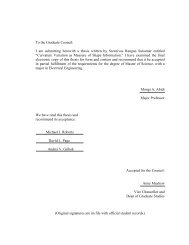To the Graduate Council: I am submitting herewith a dissertation ...
To the Graduate Council: I am submitting herewith a dissertation ...
To the Graduate Council: I am submitting herewith a dissertation ...
- No tags were found...
Create successful ePaper yourself
Turn your PDF publications into a flip-book with our unique Google optimized e-Paper software.
Chapter 2: Related Work 18<strong>To</strong> model <strong>the</strong> transformations aligning <strong>the</strong> images several approaches were used.Global par<strong>am</strong>etric transformations, such as affine and projective warps, assume that asingle set of par<strong>am</strong>eters will be valid for <strong>the</strong> whole image. More accurate localpar<strong>am</strong>etric mappings were employed for registration and image warping [Zitova03].O<strong>the</strong>r methods while global in nature are capable of modeling local deformations,<strong>the</strong>se include radial basis functions techniques, chief <strong>am</strong>ong which are Thin-plateSplines methods [Bookstein89]. While <strong>the</strong>se above methods were mostly used in <strong>the</strong>case feature correspondences are available, o<strong>the</strong>r techniques recover bothcorrespondences and transformations at <strong>the</strong> s<strong>am</strong>e time. For ex<strong>am</strong>ple ano<strong>the</strong>r approachused in <strong>the</strong> case of images with complex and/or local deformation is elasticregistration, introduced by Bajcsy [Bajcsy89]. These techniques modeled <strong>the</strong> imagesas pieces of an elastic rubber sheet that are subject to external stretching forces andinternal smoothness and stiffness constraints that bring <strong>the</strong>m into alignment withminimal <strong>am</strong>ount of bending and stretching. The external forces are derived byoptimization of a similarity function defined on <strong>the</strong> intensity values or on <strong>the</strong> boundarystructures.In <strong>the</strong> case of very localized deformations registration can be addressed by <strong>the</strong> socalledfluid registration, where a viscous fluid model was used to model <strong>the</strong> flow ofone image in <strong>the</strong> process of aligning with <strong>the</strong> reference image [Woolny02]. Inaddition o<strong>the</strong>r non-rigid methods are commonly used including diffusion registration[Thirion98][Andersen01], and PDE-driven level sets [Hermosillo02]. For a thoroughrecent survey on image registration techniques we refer to Zitova and Flusser[Zitova03]. In this research <strong>the</strong> application of our new matching criterion to imageregistration was somewhat limited when compared to our work on 3D alignment;none<strong>the</strong>less we are convinced that our fr<strong>am</strong>ework will be very useful for bothmultimodal and single-sensor image alignment under different non-rigidtransformation models.
















